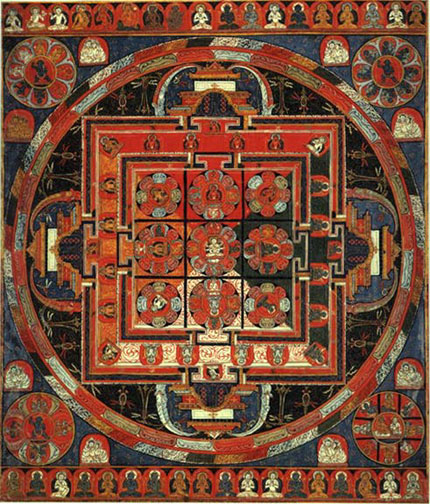| Vajradhatu Mandala bcom-ldan rdo-rje'i dbyings-kyi dkyil-'khor Central Tibet, ca. 14th century 68.5 x 60 cm |
|
Vairocana in his four-faced, eight-armed form presides over this mandala of Vajradhatu, the "Diamond Realm." Nine lotuses arranged in three registers support deities within the main chamber (kutagara). In the center lotus is Sarvavid ("The Omniscient")
Vairocana, surrounded by Sattvavajri (E), Ratnavajri (S), Dharmavajri (W), and Karmavajri (N). The lotuses which mark the cardinal points of the compass support four celestial Buddhas (tathagata), each attended by four of the sixteen "vajra bodhisattvas.
"1 At the four intermediate points of the compass, each within their own lotus, are the offering goddesses: Lasya (SE; amorous dance), Mala (SW; rosary), Gita (NW; song) and Nrtya (NE; dance). Other bodhisattvas appear in rows just beyond the walls of t
he main mandala palace, making another group of sixteen bodhisattvas. Four further goddesses of offering mark the intermediate points of this circle, and at the palace gates are four female guardians. An inscription at the bottom of the painting identifies the mandala and specifies the four circles of deities outside the mandala proper: "In the mandala of the Victorious Vajradhatu, the eight great [Hindu] gods, the nine great terrifying ones, the four great kings, and the ten protectors of the directions are seated in the four corners. In the realms of lower beings, the planets and constellations and the eight great water spirits, the Nagas, are well seated. They are givers of the treasures of attain ment." The eight great Hindu gods are depicted in the lotus in the upper left corner of the painting; the nine terrifying ones (Bhairava in the center and eight subsidiary manifestations), in the upper right; the four great kings (Dhrtarastra, E; Virudhaka, S; V irupaksa, W; and Vaisravana, N) are in the lower left corner; and the ten protectors of the realm, in the lower right. The planets and constellations are seen in the top register, beginning at the left. Eight naga couples surround the four assemblies de scribed in the inscription. 1 This mandala follows an iconographic description in the nineteenth chapter of the NSP. For identification of all deities in this mandala, see Mallmann, Introduction a l'iconographie du tantrisme bouddhique, pp. 57-58. |
